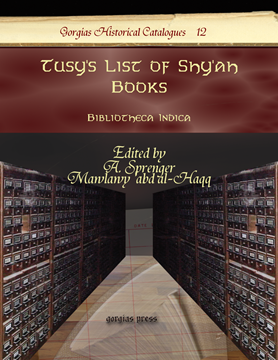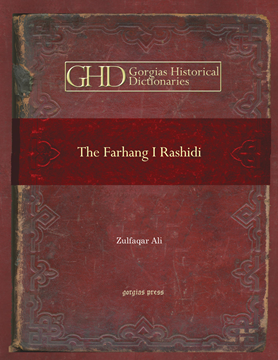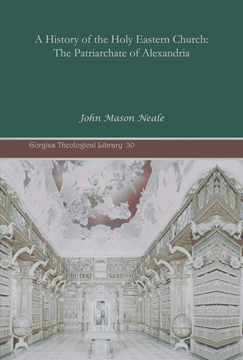Tusy's List of Shy'ah Books
Bibliotheca Indica
Edited by A. Sprenger & Mawlawy 'abd al-Haqq
Series: Kiraz Historical Catalogues Archive 12
ISBN: 978-1-59333-914-2
Among the earliest important Shiite works is that of Tusy’s List of Shiites Books. This reprint of the first publication of the work bears all the marks of a primary source, and it was a work heralded by Islamic scholars of late antiquity. Also included in this edition is the new edition of a supplement to Tusy’s bibliography prepared by Alam al-Hoda. The notes from this text are replicated at the bottom of the page. A useful resource for scholars of ancient bibliography, this uncommon source of Arabic scholarship is now again available, in its original language, for the Arabic reader interested in the history of bibliography.
$181.00 (USD) $108.60 (USD)
Maasir I Alamgiri of Muhammad Saqi Musta'idd Khan
Bibliothec Indica
ISBN: 978-1-59333-915-9
Written in the original Persian, this account of the reign of the Mughal emperor Aurangzib-Alamgir (reigned 1658-1707) is a standard resource for the this final great ruler of the empire. The chronicles of the emperors of this period in India are in general a blend of biography and history, but in the case of Aurangzib, the emperor is portrayed in terms of unstinting praise. Comprising both official sources, such as court circulars and letters, and personal recollections, the work was initiated by Mirza Muhammad Kazim, put aside until after the Emperor’s death, and completed in 1710 by Saqi Must`ad Khan.
$238.00 (USD) $142.80 (USD)
The Greek-Turkish War 1919–23
An Australian Press Perspective
Series: Conflict and Trade 1
ISBN: 978-1-59333-967-8
The book describes different facets of the Greek-Turkish conflict (1919-23) through the eyes of of the Australian press. Australia’s national identity was forged on the shores of the Gallipoli Peninsula fighting against the Ottoman Empire in 1915. After the war, Australia stayed involved with that area of the world as it sought to chart an 'independent' foreign policy within the framework of the British Empire. This book discusses the role that Australia's press played during that conflict and how it shaped Australian nationalism and identity going forward.
$175.00 (USD) $105.00 (USD)
The Farhang I Rashidi
A Persian Dictionary by Sayyid Abdurrashid
By Zulfaqar Ali
Series: Kiraz Historical Dictionaries Archive 20
ISBN: 978-1-59333-916-6
The famous Persian dictionary of Sayyid Abdurrashid, now quite difficult to locate, is an historic dictionary to which linguists still make reference. The Farhang I Rashidi was compiled by the Persian scholar Abd ur-Rashid bin Abd ul-Ghafur Husaini al-Madani al-Tattawi (d. 1653) who lived in Thatta, now the Sindh province of Pakistan. One of two dictionaries compiled by Abd ur-Rashid, this lexicon, presented entirely in Classic Persian, marks a turning point in Persian lexicography and ranks as one of the cultural and literary achievements of the seventeenth century. The two volumes of this historic dictionary are here bound together, providing an affordable alternative to earlier two-part editions.
$257.00 (USD) $154.20 (USD)
The Palestinan Syriac Lectionary of the Gospels
Series: Kiraz Theological Archive 33
ISBN: 978-1-59333-917-3
The work of the remarkable sisters Agnes Smith Lewis and Margaret Dunlop Gibson, this lectionary of what is now known as Christian Palestinian Aramaic, was re-edited in the light of two manuscripts from the Sinai, which they recovered, and from Paul de Lagarde’s Evangeliarium Hierosolymitanum. An important document for the textual criticism of the New Testament as well as for the early practice of the church, Lewis and Dunlap added to its value by composing this light “critical edition.” Presented in Syriac with English annotations to the Greek text of the Gospels, this useful study will be welcome by New Testament scholars and Syriac scholars alike.
$181.00 (USD) $108.60 (USD)
The Patriarchate of Alexandria
Series: Kiraz Theological Archive 30
ISBN: 978-1-59333-050-7
The first volume of an ambitious project to document the history of the early church, this is one of John Mason Neale’s crowning achievements. Meticulously researched, Neale’s treatment of the early church in Egypt is among the required reading of any student of oriental Christianity still today. Beginning with the traditions of St. Mark’s foundation of the Egyptian church, the developments of Christianity are traced up through the controversies associated with Nestorius and the Council of Chalcedon. In Neale’s characteristically readable style, the early stages of Eastern Christianity and its noteworthy figures are presented here with historical accuracy and authority. The origins of monasticism, the troubles and triumphs of St. Athanasius, the Arian heresy, and the ecumenical councils are all treated in this important study of the church in Egypt.
$167.00 (USD) $100.20 (USD)





